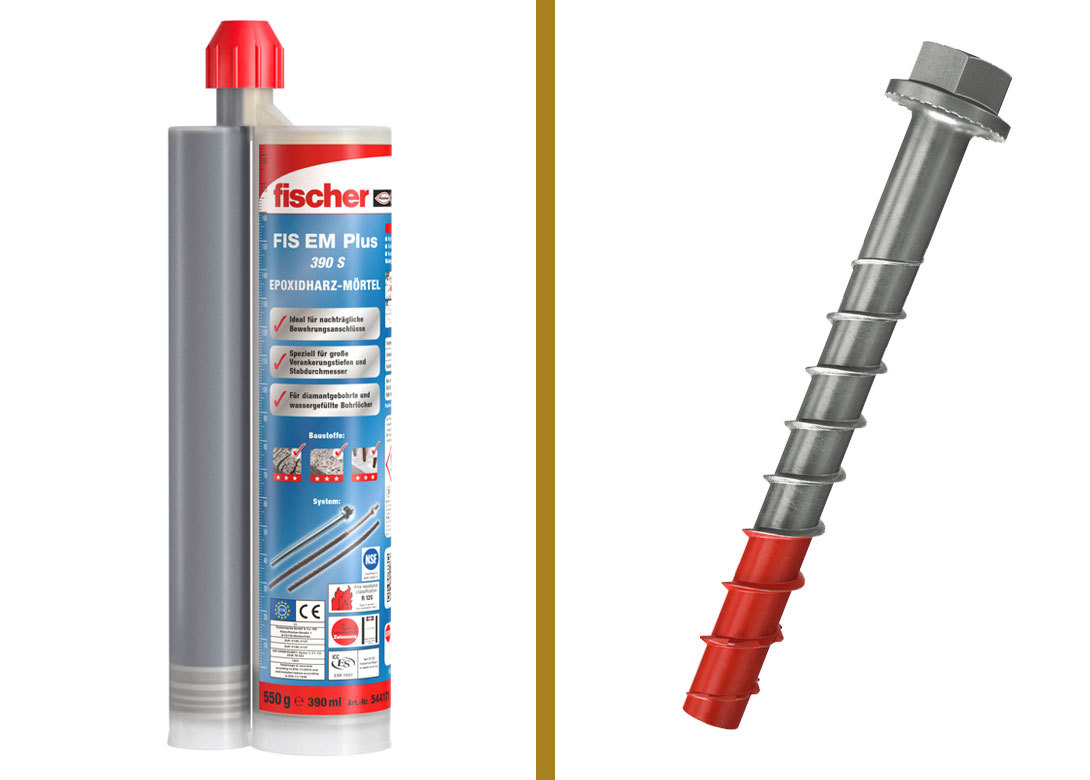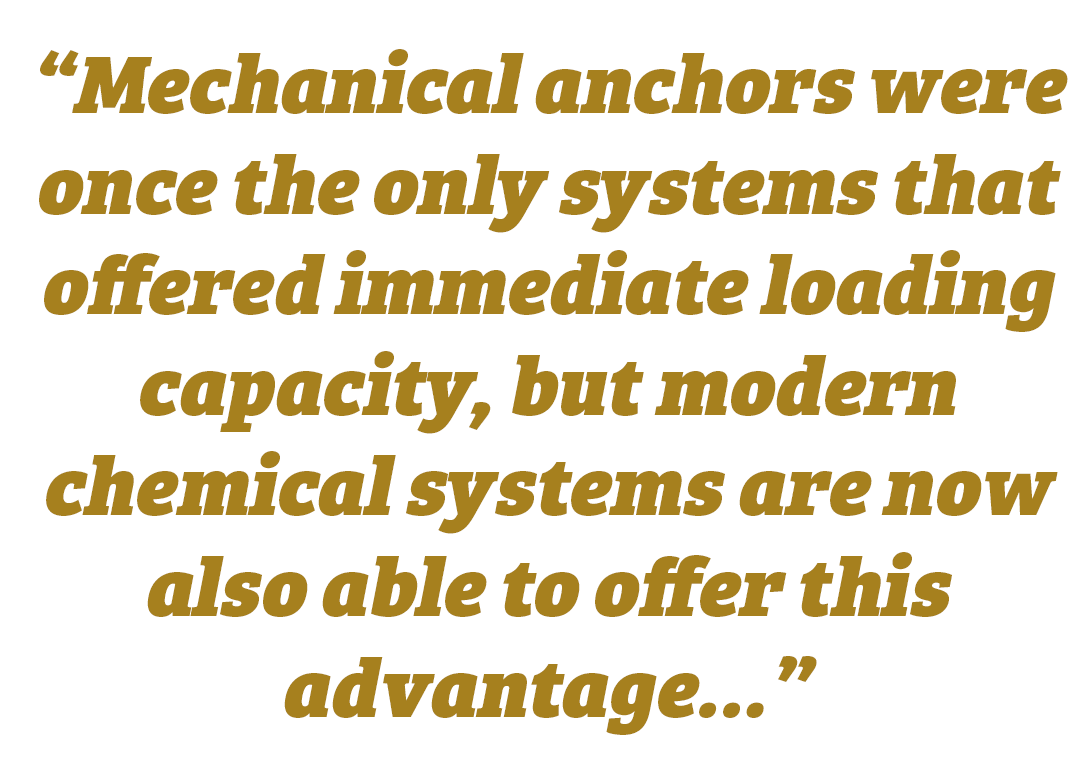
By Andreas Cardinal, application engineer at fischer Deutschland Vertriebs GmbH
Anyone who is familiar with selecting suitable fixings knows that a large range of various systems are on offer, which can be confusing. This is no mean feat, particularly when it comes to safety applications. One of the first decisions users must make is the choice between mechanical and chemical systems.
One part of the mechanical anchor is activated via the torque applied during installation, the so-called torque controlled expansion anchor. This group includes classic bolt anchors as well as sleeve anchors. Other anchors expand by being hammered in using a hammerset tool, these are so-called deformation controlled expansion anchors. This group includes classic hammer set anchors.
Another category which should be mentioned is the undercut system, which also includes the concrete anchor. One of the disadvantages of the mechanical fixings is their expansion behaviour while being positioned. In order to benefit from their full effect, these anchors must effectively be pressed against the borehole wall, which can result in the formation of depressions in the concrete.
This results in high expansion forces during the anchor’s activation, which requires sufficient component volume around the borehole in order for the concrete to be able to absorb the ensuing tensile stress without damage. This requires larger edge distances. To that effect, anchors have undergone significant optimisation in recent years, so that mechanical anchors can now be used in concrete with shorter edge distances.
In conclusion, whether or not mechanical anchors can be used in masonry should be carefully examined, in addition to the type of anchor to be used. Using these anchors in hollow blocks or vertically perforated bricks is rather problematic. Frame fixings are an exception, as the fischer SXRL is suitable for almost any type of anchor substrate. In most cases, the SXRL exceeds the load values of comparable frame fixings. Its two expansion zones apply force without damaging the base. The two zones combine into one long expansion element in solid building materials and aerated concrete, evenly distributing the loads into the subsurface. Using classic mechanical anchors in solid construction materials is associated with the risk of the stone splitting. A concrete screw such as fischer’s ULTRACUT FBS II is a safe solution for solid brick, however it requires professional installation that takes all manufacturer instructions into account.

One of the advantages of mechanical anchors is the fact that they tend to be more economic. The anchor itself as well as the method of clearing the drill hole play an important role. As a rule, mechanical anchors don’t react nearly as badly to drill holes that have been insufficiently cleaned. Nevertheless, drill holes should always be cleaned according to the guidelines set out in the ETA, as this significantly affects the load-bearing capacity.
Another advantage of mechanical anchors is the fact that the clearance hole required for push-through installation is smaller than that of comparable chemical systems. Concrete screws can even be reused, however this only applies to temporary connections on construction sites, for instance when anchoring formwork supports. The number of times it is possible to reuse the fixing depends on the screw’s wear, which can easily be tested using a test sleeve. A concrete screw should never be inserted into the same drill hole more than once under any circumstances.
While the first mechanical anchors could only be used at a set predefined anchoring depth, anchors are now available that permit multiple or even flexible anchoring depths. This primarily applies to bolt anchors and concrete screws.

Chemical anchors have become increasingly important in recent years. The first systems to be launched were anchor rods and glass capsules. The first ETAs only applied to non-cracked concrete. The introduction of specialist anchor rods with a cone geometry enabled additional applications in cracked concrete. The same calculations that were used for mechanical anchors were initially applied to these first systems.
In addition to the capsule systems, the market eventually saw the launch of less delicate film bag and cartridge systems. Each one of these systems has its advantages and disadvantages. In general, glass capsule systems are more resistant to poorly cleaned drill holes, as the glass is destroyed when it is inserted in the hole, thereby clearing the drill hole wall. This is also why capsule systems are better suited for diamond drilled boreholes. As with many mechanical anchors, the disadvantage of these systems is that they can only be used at a set anchoring depth. Systems are now also available that allow multiple anchoring depths through a combination of various capsules.
Injection systems are more flexible, enabling anchoring depths between 4 x the anchor diameter and 20 x the anchor diameter. No additional tools are required to insert the anchor rod into the mortar. Capsule systems on the other hand require a sufficiently heavy hammer drill to be inserted, which requires additional adapters.
The ability to use regular threaded rods in cracked concrete has expanded the range of applications for more cost-effective fixings. Another advantage of these systems is the fact that they don’t require an additional installation torque to be applied. This allows fixings to be carried out which would otherwise have required a great deal of effort. This includes installations in EWI system as well as other bases that are not pressure proof.
All of the chemical systems offer one major advantage: There is no expanding force when placing the anchors. However, all systems generate expanding force when they are subjected to loads. This expanding force is lower when it comes to chemical systems however, as the load is transferred into the construction base due to the large bonded length, meaning it is distributed across a larger area.
One of the disadvantages of these systems that must be mentioned is that the durability is reduced in case of heavy constant tensile load. A reduction factor was therefore introduced for the calculations, which means that the difference between the mechanical anchor’s tensile load is slightly smaller, even under similar edge conditions. Higher requirements also apply when it comes to cleaning the drill hole, although significant progress has been made in recent years. Chemical systems also tend to be more expensive, and require additional annular gap filling measures when applying push-through installation methods. Capsule systems can therefore often only use prepositioned methods of installation.

Injection systems are the first choice when it comes to anchorings in masonry, and they are the only choice when it comes to approvals for specific uses. Capsule systems are not an option in this case. In order to enable secure placement, the anchor rods are placed in masonry that is likely to contain cavities or in perforated brick using anchor sleeves. The mortar is then injected into the sleeve which is placed in the stone, after which the threaded rode is inserted into the fresh mortar. This guarantees that the mortar evenly spreads in the stone through the perforations in the sleeve. There is no need for a sleeve in solid bricks. The corresponding approvals indicate which combinations are suitable for which type of stone.
The temperature plays an important role for all chemical systems, no matter whether they are used in concrete or masonry. While chemical anchors could once only be used in temperatures above zero, fixings can now be carried out at temperatures of up to minus 30 degrees thank to high performance systems.
Mechanical anchors were once the only systems that offered immediate loading capacity, but modern chemical systems are now also able to offer this advantage. Epoxy resin chemical systems may offer the best load-bearing capacity, but their curing times are longer and can take up to an entire day in low temperature ranges.

Having spent a decade in the fastener industry experiencing every facet – from steel mills, fastener manufacturers, wholesalers, distributors, as well as machinery builders and plating + coating companies, Claire has developed an in-depth knowledge of all things fasteners.
Alongside visiting numerous companies, exhibitions and conferences around the world, Claire has also interviewed high profile figures – focusing on key topics impacting the sector and making sure readers stay up to date with the latest developments within the industry.






